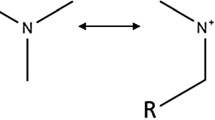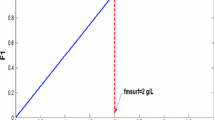Abstract
Foam is injected in the subsurface to improve mobility control through the increase in the effective gas viscosity, e.g., in CO\(_2\)-based enhanced oil recovery processes. As fine-textured foam has higher viscosity, it is envisaged to achieve an optimal foam texture and to maintain it for the entire period of an application. However, mechanisms of foam formation and destruction, which affect texture, are difficult to regulate. In this study, we investigate the synergic effect of nanoparticles and surfactant on the foam texture and the effective gas viscosity (\(\mu _g^f\)) during transport in a porous medium. Experiments using glass-bead packs were performed injecting CO\(_2\) and a solution containing either only surfactant or surfactant and nanoparticles. During each experiment, the pressure drop (\(\Delta p\)) through the porous medium was measured to follow the generation of the foam. A two-phase flow mechanistic model combining the mass conservation law for water and CO\(_2\) and the population balance equation of the lamellae was implemented to analyze the experiments and predict foam transport under the investigated conditions. The constitutive equations for foam generation and destruction were based on the dominant role of pressure gradient on lamella division and of capillary pressure on bubble coalescence, and their parameters were estimated using pressure drop measurements. Both equations were formulated for a surfactant-stabilized foam, and it was the aim of this work to understand their validity also for the case of a nanoparticle-stabilized foam. The experiments compare well with the theory showing that a foam stabilized with nanoparticles and surfactant can be modeled as a surfactant-stabilized foam. Overall, \(\Delta p\) increases smoothly while the foam forms and, upon breakthrough, it stabilizes around a constant value while approaching steady state. During this phase, oscillations occur, particularly when high-quality foam is generated as the system is close to its critical conditions of capillary pressure and water saturation. When steady state is reached, the effective gas viscosity varies with \(f_g\) and solution composition and significantly increases when surfactant and nanoparticles are added. The maximum value of \(\mu _g^f\) is 0.110 Pa s for \(f_g\) = 0.75, which is almost twofold of the maximum value attained when only a surfactant is used, corresponding to 0.067 Pa s at \(f_g\) = 0.4. This suggests that when nanoparticles and surfactant are employed, they can favor the formation of a strong high-quality CO\(_2\)-foam.









Similar content being viewed by others
References
Afsharpoor, A., Lee, G., Kam, S.: Mechanistic simulation of continuous gas injection period during surfactant-alternating-gas (SAG) processes using foam catastrophe theory. Chem. Eng. Sci. 65(11), 3615–3631 (2010)
Alvarez, J.M., Rivas, H.J., Rossen, W.R.: Unified model for steady-state foam behavior at high and low foam qualities. SPE J. 6(3), 325–333 (2001)
Aronson, A., Bergeron, V., Fagan, M., Radke, C.: The influence of disjoining pressure on foam stability and flow in porous media. Coll. Surf. A Physicochem. Eng. Asp. 83(2), 109–120 (1994)
Aroonsri, A., Worthen, A., Hariz, T., Johnston, K., Huh, C., Bryant, S.: Conditions for generating nanoparticle-stabilized CO\(_2\) foams in fracture and matrix flow. In: SPE Annual Technical Conference and Exhibition. Society of Petroleum Engineers (2013)
Ashoori, E., Marchesin, D., Rossen, W.: Roles of transient and local equilibrium foam behavior in porous media: traveling wave. Coll. Surf. A Physicochem. Eng. Asp. 377(1–3), 228–242 (2011a)
Ashoori, E., Marchesin, D., Rossen, W.: Dynamic foam behavior in the entrance region of a porous medium. Coll. Surf. A Physicochem. Eng. Asp. 377(1), 217–227 (2011b)
Ashoori, E., Marchesin, D., Rossen, W.: Stability analysis of uniform equilibrium foam states for eor processes. Transp. Porous Media 92(3), 573–595 (2012)
Aveyard, R., Clint, J.H., Nees, D.: Small solid particles and liquid lenses at fluid/fluid interfaces. Colloid Polym. Sci. 278(2), 155–163 (2000)
Azmin, M., Mohamedi, G., Edirisinghe, M., Stride, E.: Dissolution of coated microbubbles: the effect of nanoparticles and surfactant concentration. Mater. Sci. Eng. C 32(8), 2654–2658 (2012)
Beck, J.V., Arnold, K.J.: Parameter Estimation in Engineering and Science. Wiley, New York (1977)
Binks, B.P., Desforges, A., Duff, D.G.: Synergistic stabilization of emulsions by a mixture of surface-active nanoparticles and surfactant. Langmuir 23(3), 1098–1106 (2007)
Binks, B.P., Clint, J.H.: Solid wettability from surface energy components: relevance to pickering emulsions. Langmuir 18(4), 1270–1273 (2002)
Collins, R.: Flow of Fluids Through Porous Materials. Research & Engineering Consultants Inc, Englewood (1961)
Dickinson, E., Ettelaie, R., Kostakis, T., Murray, B.S.: Factors controlling the formation and stability of air bubbles stabilized by partially hydrophobic silica nanoparticles. Langmuir 20(20), 8517–8525 (2004)
Du, Z., Bilbao-Montoya, M.P., Binks, B.P., Dickinson, E., Ettelaie, R., Murray, B.S.: Outstanding stability of particle-stabilized bubbles. Langmuir 19(8), 3106–3108 (2003)
Espinosa, D.A., Caldelas, F.M., Johnston, K.P., Bryant, S.L., Huh, C.: Nanoparticle-stabilized supercritical CO\(_2\) foams for potential mobility control applications. In: SPE Improved Oil Recovery Symposium: Proceedings, 24–28 April 2010, Tulsa, Oklahoma, USA, The Society of Petroleum Engineers, Richardson, TX, p. Paper 129925 (2010)
Farajzadeh, R., Andrianov, A., Bruining, H., Zitha, P.L.J.: Comparative study of CO\(_2\) and N\(_2\) foams in porous media at low and high pressure? Temperatures. Ind. Eng. Chem. Res. 48(9), 4542–4552 (2009)
Gauglitz, P.A., Friedmann, F., Kam, S.I., Rossen, W.R.: Foam generation in homogeneous porous media. Chem. Eng. Sci. 57(19), 4037–4052 (2002)
Hirasaki, G., Jackson, R., Jin, M., Lawson, J., Londergan, J., Meinardus, H., Miller, C., Pope, G., Szafranski, R., Tanzil, D.: Field demonstration of the surfactant/foam process for remediation of a heterogeneous aquifer contaminated with DNAPL. In: Fiorenza, S., Miller, C.A., Oubre, C.L., Ward, C.H. (eds.) In NAPL Removal: Surfactants, Foams, and Microemulsions. Lewis, Boca Raton (2000)
Hirasaki, G.J., Lawson, J.B.: Mechanisms of foam flow in porous media: apparent viscosity in smooth capillaries. Soc. Pet. Eng. 25(20), 176–190 (1985)
Horozov, T.S.: Foams and foam films stabilised by solid particles. Curr. Opin. Colloid Interface Sci. 13(3), 134–140 (2008)
Hunter, T.N., Pugh, R.J., Franks, G.V., Jameson, G.J.: The role of particles in stabilising foams and emulsions. Adv. Colloid Interface Sci. 137(2), 57–81 (2008)
Jiménez, A., Radke, C.: Dynamic stability of foam lamellae flowing through a periodically constrained pore. In: Borchardt, J.K., Yen, T.F. (eds.) Oil-Field Chemistry, Enhanced Recovery and Production Stimulation. America Chemical Society, Washington, DC (1961)
Kam, S.I., Nguyen, Q.P., Li, Q., Rossen, W.R.: Dynamic simulations with an improved model for foam generation. SPE J. 12(01), 35–48 (2007)
Kam, S., Rossen, W.: A model for foam generation in homogeneous porous media. SPEJ 8, 417–425 (2003)
Kaptay, G.: Interfacial criteria for stabilization of liquid foams by solid particles. Coll. Surf. A 230(1–3), 67–80 (2003)
Khatib, Z.I., Hirasaki, G.J., Falls, A.H.: Effects of capillary pressure on coalescence and phase mobilities in foams flowing through porous media. SPE Reserv. Eng. 3(03), 919–926 (1988)
Kovscek, A., Patzek, T., Radke, C.: A mechanistic population balance model for transient and steady-state foam flow in Boise sandstone. Chem. Eng. Sci. 50(23), 3783–3799 (1995)
Kovscek, A., Radke, C.: Fundamentals of foam transport in porous media. ACS Adv. Chem. Ser. 242, 115–164 (1994)
Lake, L.W.: Enhanced Oil Recovery. Prentice Hall, Upper Saddle River (1989)
Lee, S., Lee, G., Kam, S.: Three-phase fractional flow analysis for foam-assisted non-aqueous phase liquid NAPL remediation. Transp. Porous Media 101(3), 373–400 (2014)
Leverett, M.: Capillary behavior in porous solids. Trans. Am. Inst. Min. Metall. Eng. 142, 152–169 (1941)
Mulligan, C.N., Eftekhari, F.: Remediation with surfactant foam of PCP-contaminated soil. Eng. Geol. 70(3–4), 269–279 (2003)
Murray, B.S., Ettelaie, R.: Foam stability: proteins and nanoparticles. Curr. Opin. Colloid Interface Sci. 9(5), 314–320 (2004)
Orr, F.M., Taber, J.J.: Use of carbon dioxide in enhanced oil recovery. Science 224(4649), 563–569 (1982)
Plug, W.J., Bruining, J.: Capillary pressure for the sand CO\(_2\) water system under various pressure conditions. Application to CO\(_2\) sequestration. Adv. Water Resour. 30(11), 2339–2353 (2007)
Prud’homme, R.K.: Foams: Theory, Measurements and Applications, vol. 57. CRC Press, Boca Raton (1995)
Ramsden, W.: Separation of solids in the surface-layers of solutions and ’suspensions’ (observations on surface-membranes, bubbles, emulsions, and mechanical coagulation). Preliminary account. Proc. R. Soc. Lond. 72(477–486), 156–164 (1903)
Ransohoff, T.C., Radke, C.J.: Mechanisms of foam generation in glass-bead packs. Soc. Pet. Eng. 3(2), 573–585 (1988)
Rossen, W.R.: Snap-off in constricted tubes and porous media. Coll. Surf. A 166(1), 101–107 (2000)
Rossen, W.R., Gauglitz, P.A.: Percolation theory of creation and mobilization of foams in porous media. AIChE J. 36(8), 1176–1188 (1990)
Rossen, W., Lu, Q.: Effect of capillary crossflow on foam improved oil recovery. SPE 3831, 579–589 (1997a)
Rossen, W., Lu, Q., et al.: Effect of capillary crossflow on foam improved oil recovery. In: SPE Western Regional Meeting. Society of Petroleum Engineers (1997b)
Sethumadhavan, G., Bindal, S., Nikolov, A., Wasan, D.: Stability of thin liquid films containing polydisperse particles. Coll. Surf. A 204(13), 51–62 (2002)
Singh, G., Hirasaki, G.J., Miller, C.A.: Dynamics of foam films in constricted pores. AIChE J. 43(12), 3241–3252 (1997)
Singh, V., Wang, S., Kool, E.T.: Genetically encoded multispectral labeling of proteins with polyfluorophores on a DNA backbone. J. Am. Chem. Soc. 135(16), 6184–6191 (2013)
Tanzil, D., Hirasaki, G.J., Miller, C.A.: Conditions for foam generation in homogeneous porous media. Presented at SPE/DOE Improved Oil Symposium, Tulsa, 13–17 April 2002
Worthen, A.J., Bryant, S.L., Huh, C., Johnston, K.P.: Carbon dioxide-in-water foams stabilized with nanoparticles and surfactant acting in synergy. AIChE J. 59(9), 3490–3501 (2013)
Worthen, A.J., Bagaria, H.G., Chen, Y., Bryant, S.L., Huh, C., Johnston, K.P.: Nanoparticle-stabilized carbon dioxide-in-water foams with fine texture. J. Colloid Interface Sci. 391, 142–151 (2013)
Worthen, A.J., Parikh, P.S., Chen, Y., Bryant, S.L., Huh, C., Johnston, K.P.: Carbon dioxide-in-water foams stabilized with a mixture of nanoparticles and surfactant for CO\(_2\) storage and utilization applications. Energy Procedia 63, 7929–7938 (2014). 12th International Conference on Greenhouse Gas Control Technologies, GHGT-12
Xue, Z., Foster, E., Wang, Y., Nayak, S., Cheng, V., Ngo, V.W., Pennell, K.D., Bielawski, C.W., Johnston, K.P.: Effect of grafted copolymer composition on iron oxide nanoparticle stability and transport in porous media at high salinity. Energy Fuels 28(6), 3655–3665 (2014)
Yu, J., An, C., Mo, D., Liu, N., Lee, R.L.: Foam mobility control for nanoparticle-stabilized supercritical CO\(_2\) foam. Society of Petroleum Engineers (2012)
Yu, J., Khalil, M., Liu, N., Lee, R.: Effect of particle hydrophobicity on CO\(_2\) foam generation and foam flow behavior in porous media. Fuel 126, 104–108 (2014)
Zhang, Z.F., Zhong, L., White, M.D., Szecsody, J.E.: Experimental investigation of the effective foam viscosity in unsaturated porous media. Vadose Zone J. 11(4) (2012)
Zhang, S., Sun, D., Dong, X., Li, C., Xu, J.: Aqueous foams stabilized with particles and nonionic surfactants. Coll. Surf. A 324(1–3), 1–8 (2008)
Acknowledgments
This material is based upon work supported by the Department of Energy under Award Number DE-DE0005917. The authors would like to thank Parth S. Parikh, Tyler R. Dickey, Jefferson S. Liu, and Vu Tran for performing some of the experiments reported in the manuscript and Dr. Ijung Kim for collecting the TEM images. Finally, the authors would like to thank the anonymous reviewers for their valuable comments and suggestions.
Author information
Authors and Affiliations
Corresponding author
Electronic supplementary material
Below is the link to the electronic supplementary material.
Rights and permissions
About this article
Cite this article
Prigiobbe, V., Worthen, A.J., Johnston, K.P. et al. Transport of Nanoparticle-Stabilized CO\(_2\)-Foam in Porous Media. Transp Porous Med 111, 265–285 (2016). https://doi.org/10.1007/s11242-015-0593-7
Received:
Accepted:
Published:
Issue Date:
DOI: https://doi.org/10.1007/s11242-015-0593-7




